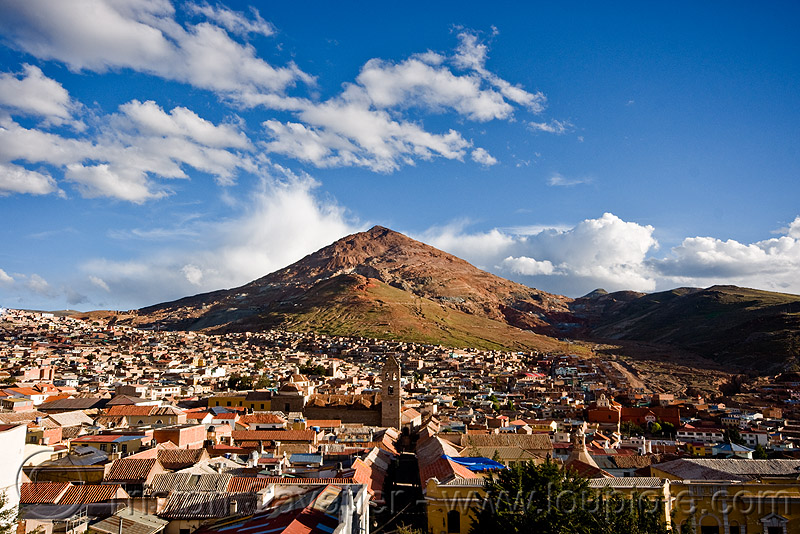In the year 1545, a man by the name Diego Huallpa accidentally discovered Potosi in Boliva, also known as Cerro Rico.1 Cerro Rico means rich mountains, which, in this case, it definitely was. When traveling between cities, Diego Huallpa was asked to climb a mountain; after getting to the top he slipped and fell and found on the side of the mountain some silver. Diego Huallpa immediately took his findings to his boss, which was a Spanish overseer at a nearby mine. Shortly after, that mountain was quickly inhabited by thousands of Spaniards and Indians. The silver of this mountain quickly drew the attention of the Spanish conquistadors. When these conquistadors arrived, they began to colonize the area surrounding the mountain.2 By 1672, the surrounding area reached its highest population of 200,000 people, and was one of the richest cities of its era.3 It became a very strong anchor for the Spanish Empire. This city sent Spain’s economy to new heights, making the Spanish more powerful than before.4
Silver during the sixteenth century was one of the most sought-after metals in all of Spain.5 The area itself surrounding the mountain was not a healthy environment, and the air was constantly filled with dust and debris. Miners were only expected to live to be around forty years old.6 To make matters worse, Potosi is the highest city in the world, making the air thin and hard to breathe. The city resides 4000 meters above sea level.7 All in all, the surrounding area was a cruel place to live, but the Spaniards stayed due to the wealth they achieved. This wealth was achieved easily for the Spanish, but came at a great price to the indigenous Indians and to the African slaves.8

Potosi was a cruel, horrible place for anyone who worked there. The process of mining in the sixteenth century was not an easy one. It was extremely laborious and hard for all miners. The Spanish conquered the Andeans and put them through rough, intensive work.9 Though the Indians were not slaves they were sometime treated as such. Some Spanish conquistadors would lend Indians under their care to other miners. At Potosi, as elsewhere in Spanish South America, the Spanish implemented the mita system of labor. In this system, miners would be given a certain number of days to work per week, and then they would relax on the other days. Though it was more intense, all ages would be put to work, ranging from eighteen to fifty years old.10 Before the Spanish empire found an easier way to mine, they used the classic way of mining, which was extremely laborious.11 The Indians were to use iron bars to chip out iron ores, which was then carried down the mountain, where it would be heated in order to extract the silver.12 The mountain was a very dangerous place, due to its close spaces with very little air.
The silver industry in the sixteenth century really flourished. It was in great demand and needed for the Spanish and Europeans.13 Even though mining slowed down after Bolivia received independence, Potosi, still to this day is a high producer of silver.14 The Potosi mountains have had several years where they have really good production, but that has also come with several bad years.15 Still to this day Potosi is a high producer of silver and tin, causing Potosi to be one of the oldest mining cities in the New World.16
- Oxford Research Encyclopedia, May 2015, s.v. “Potosí Mines,” by Kris Lane. ↵
- Oxford Research Encyclopedia, May 2015, s.v. “Potosí Mines,” by Kris Lane. ↵
- New World Encyclopedia, February 2017, s.v. “Potosí.” ↵
- Oxford Research Encyclopedia, May 2015, s.v. “Potosí Mines,” by Kris Lane. ↵
- History of World Trade Since 1450, 2006, s.v. “Potosí,” by Peter Bakewell. ↵
- New World Encyclopedia, February 2017, s.v. “Potosí.” ↵
- Oxford Research Encyclopedia, May 2015, s.v. “Potosí Mines,” by Kris Lane. ↵
- Tom Zoellner, “The Mountain That Eats Men,” World Literature Today (serial online) 88(3/4) (May 2014): 83-87. ↵
- Oxford Research Encyclopedia, May 2015, s.v. “Potosí Mines,” by Kris Lane. ↵
- Oxford Research Encyclopedia, May 2015, s.v. “Potosí Mines,” by Kris Lane. ↵
- Tom Zoellner, “The Mountain That Eats Men,” World Literature Today (serial online) 88(3/4) (May 2014): 83-87. ↵
- Oxford Research Encyclopedia, May 2015, s.v. “Potosí Mines,” by Kris Lane. ↵
- History of World Trade Since 1450, 2006, s.v. “Potosí,” by Peter Bakewell. ↵
- New World Encyclopedia, February 2017, s.v. “Potosí.” ↵
- Oxford Research Encyclopedia, May 2015, s.v. “Potosí Mines,” by Kris Lane. ↵
- Oxford Research Encyclopedia, May 2015, s.v. “Potosí Mines,” by Kris Lane. ↵



63 comments
Nathaniel Bielawski
I couldn’t imagine myself working in the mines of Potosi. The conditions the miners were put through were probably the most horrific with the lack of modern technology and safety systems in place. Thanks to the miners of Potosi, Spain would grow to become one of the most powerful countries at this point in history.
Sara Guerrero
I knew about the large quatities of silver gathered from the americas, but I enjoyed learning about Potosi and the story about how Diego Huallapa accidentally found silver. It’s sad to see that his discovery of silver would lead to the cruelty and poor working conditions for miners. I agree that it definitely benifited the silver industry and I love the fact at the end of how Potosi is one of the oldest mining cities in the world.
David Castaneda Picon
This was a great article! I have never heard about this event in history before, so I was not aware that Potosi was the most richest city in Bolivia due to the production of silver. It really impresses me what the Spanish did in order to get richer, they didn’t care about human race and were willing to exploit native people without caring about anything but the wealth and power they were getting from the mines.
Giselle Garcia
It’s amazing how Potosi gave the Spanish such tremendous wealth from their mining of the silver in the mountains, but unfortunately it was at a great price. The Spanish forced people who they thought were beneath them, who were the Indians, to work in the mines in horrible working conditions and for long hours. It’s interesting to learn that Potosi was discovered on accident and reported to the Spanish, and if it hadn’t been discovered in that case, other empires might have come across it first and there might have been a bigger world power than the Spanish at that time.
Zachary Kobs
It is unfortunate that such wealth came with such a great cost against the humanity of those who mined the silver. Prior to reading this article, I had no clue what Potosi was or what it contributed to society but this article had just enough to explain it fully. But, it was really discovered because a guy tripped and fell into silver?
Francisco Cruzado
I remember reading about Potosi in one of Eduardo Galeano’s books and in some poems of Chocano and Simon Reyes when I was younger. Such a place certainly looked like a nightmare to me: the legends and the popular stories told that out of every ten men that entered the mines, only 4 would come out. But it turned out to be the most populated city in the New World, and the origin of a great part of the richness of XVI century Europe. I guess it is immensely important that the past is a story of contrasts and divergences, and that we cannot reduce the past to the myths that we hear, as this article points at when referring to the harsh realities of the place. Potosi, indeed, represented the great genocide that occurred in South America during the XVI century, and it is a place that deserves our memory
Claudia Sanchez
a great title that accurately labels the city of Potosi. Although the Spanish got a large amount of fortune from all the silver, it is still a travesty the working conditions these men had to endure for the Spanish crown. I would love to know the conditions of mining in that city now and if it’s safer now. Great article.
Makenzie Santana
It is sad to read that the great success of the silver industry came with so many consequences when involving the human life that worked in the mines to collect it. It is clear that within history when there us a strive for something to become succesful for finding ways to make money, that this kind of pressure when it comes to the hard working laborers in the mines that the job is severely dangerous and they were put under harsh circumstances.
Sofia Andrade
Before reading this article I was not aware that Potosi was a high producer of Silver. Because of the great amount of silver I cannot imagine how overworked the Indians and slaves were in order to produce the most amount of money for the Spaniards. The breathing conditions are also unimaginable. I did not know that Potosi is the city with the highest elevation in the world, this being the case, it only adds to the harsh conditions the workers had to endure.
Honoka Sasahara
It is so helpful, well-surmarised article to to know exactly about the mining city with its rich history, Potosi. The part of beginning of the story of Potosi was interesting for me. Diego Huallpa found the area accidentally but not on purpose. His excitement must have been tremendous when he saw the silver and became the first person to found it. I guess the discovery made the city what it is today.